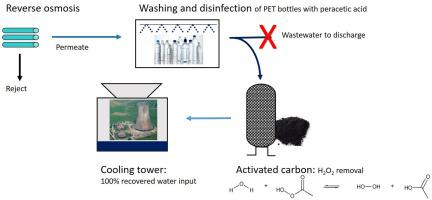Journal of Water Process Engineering ( IF 6.3 ) Pub Date : 2021-04-06 , DOI: 10.1016/j.jwpe.2021.102064 Borja Garrido Arias , Noemi Merayo , Alejandro Millán , Carlos Negro

|
Circular economy approach is needed in order to move towards sustainable development. In this frame, the current work is aimed at improving the sustainability of a food industrial plant through circular economy approach, using a waste stream, coming from the washing and disinfection of bottles before product packaging, as source of water for the cooling process. The implementation of this approach is much more relevant in sectors that are water-intensive, such as food and beverages industry. The wastewater produced as results of the washing process has quite high quality, therefore, there reuse in the cooling process is justified. However, it is needed to previously remove the hydrogen peroxide present in that wastewater stream to protect refrigeration circuits from oxidation. Hydrogen peroxide is produced as a result of the decomposition of peracetic acid, which is used as disinfection agent in the washing process, being acetic acid the other byproduct. In order to remove the hydrogen peroxide, catalytic decomposition of hydrogen peroxide with activated carbon was performed, studying both required contact time for different activated carbon/hydrogen peroxide ratios and kinetic models of hydrogen peroxide decomposition at lab scale. Subsequently, the proposed solution was applied at industrial scale, achieving 100 % water replacement in cooling towers. The solution performed in this case can be easily replicated in other plants using peracetic acid as disinfectant.
中文翻译:

冷却塔中回用的废水的可持续回收:朝着循环经济的方向发展
为了实现可持续发展,需要采取循环经济方式。在此框架下,当前的工作旨在通过循环经济的方法来提高食品工业工厂的可持续性,利用产品包装前瓶子的洗涤和消毒所产生的废物流作为冷却过程的水源。这种方法的实施在食品和饮料行业等耗水量高的行业中具有更大的意义。洗涤过程产生的废水质量很高,因此,在冷却过程中重复使用是合理的。然而,需要预先除去废水中存在的过氧化氢以保护制冷回路免于氧化。过氧化氢的分解是过乙酸的分解产物,过乙酸在洗涤过程中用作消毒剂,而乙酸是另一种副产物。为了除去过氧化氢,进行了过氧化氢与活性炭的催化分解,研究了不同活性炭/过氧化氢比所需要的接触时间以及在实验室规模下过氧化氢分解的动力学模型。随后,提出的解决方案以工业规模应用,实现了冷却塔中100%的水替代。使用过乙酸作为消毒剂,在这种情况下执行的溶液可以很容易地在其他工厂中复制。用活性炭进行过氧化氢的催化分解,研究了不同活性炭/过氧化氢比所需的接触时间以及实验室规模的过氧化氢分解动力学模型。随后,提出的解决方案以工业规模应用,实现了冷却塔中100%的水替代。使用过乙酸作为消毒剂,在这种情况下执行的溶液可以很容易地在其他工厂中复制。用活性炭进行过氧化氢的催化分解,研究了不同活性炭/过氧化氢比所需的接触时间以及实验室规模的过氧化氢分解动力学模型。随后,提出的解决方案以工业规模应用,实现了冷却塔中100%的水替代。使用过乙酸作为消毒剂,在这种情况下执行的溶液可以很容易地在其他工厂中复制。











































 京公网安备 11010802027423号
京公网安备 11010802027423号